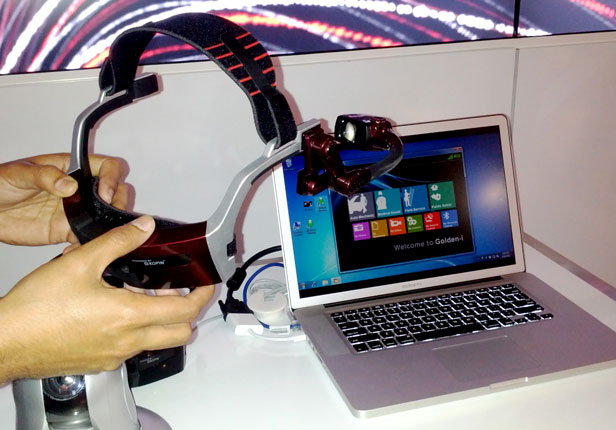Verizon Envisions 4G Wireless in Just about Anything

Tucked away in a new office block in Waltham, Massachusetts, is a kind of wireless Tomorrowland. Inside several colorfully lit chambers, visitors can marvel over a Buick that displays a live video stream from the owner’s living room, ATMs that allow wireless video chats with bank representatives, and head-mounted displays that might someday deliver live security camera video feeds to patrolling security guards.
The center was created by Verizon, which, along with other major carriers, is heavily promoting business partnerships based on its wireless broadband service—even though today’s network congestion means consumers can sometimes find it a challenge simply watching a few streaming episodes of The Simpsons on their smart phones.
The LTE Innovation Center, as it’s called, envisions all manner of devices using Verizon’s newer and faster 4G LTE network, which provides speeds up to 10 times faster than the older 3G network that is the focus of much of today’s congestion issues. (Verizon slows data transfers to 3G customers when networks are congested. AT&T slows data transfers after users hit a three-gigabyte monthly threshold.)
For now, Verizon’s LTE network has fewer than six million subscribers and isn’t being fully utilized—much less throttled—says Chetan Sharma, an independent wireless analyst based in Seattle. But as 3G subscribers migrate to LTE and more people buy smart phones, LTE congestion will become a greater risk, he adds.
Verizon is hardly the only player drumming up business. All of the major carriers are interested in boosting revenue by dreaming up and promoting new uses for faster wireless broadband—especially for business customers. “They really want to find out how to get revenue not just from consumers using networks, but from businesses,” says Janne Lindqvist, a research professor at the Winlab at Rutgers University. “I don’t find it surprising that even though they have congestion problems now, they are trying to find different ways to get more subscribers.”
Lindqvist says it’s not entirely clear how bad congestion really is, but says it’s not necessarily paradoxical to throttle data on the one hand while promoting more usage on the other. “This kind of fits the scheme: you limit consumers now so you can support more customers and applications later,” he says.

Verizon opened the testing and demonstration site last year. More than 300 employees work there with partners to develop new business models. In adjacent labs, engineers test new radio product concepts in rooms with walls that shield against stray wireless signals that could cause interference.
One business that’s already signed on is TouchTunes, a maker of interactive jukeboxes—one of which hangs on the wall at the Verizon Center. The company streams songs and video to 52,000 jukeboxes in bars and restaurants around the United States. A company spokeswoman, Liz Anklow, says an undisclosed percentage of these already use wired and wireless broadband, including both 3G and LTE, which makes it easier to sell and maintain the system in more places.
However, much of what’s on display in Waltham—save the car—could connect to available fiber connections or Wi-Fi networks, if available. But “most of this is based on the idea of ‘bring your own broadband’—everything is plug-and-play,” says Praveen Atreya, director of the center. In other words, the gadgets simply need power to operate and do not require the user to have preëxisting wired broadband service. “The vision is that there is going to be an LTE pipe providing a combination of infotainment, security services, surveillance, and home control that you can access from anywhere.”

As an example, he points to the Buick’s rear license plate. A video camera just above the plate can be programmed to dispatch a blast of streaming video when the car is bumped. You’d get a message on your smart phone and an image of who hit you, he says. Similarly, cameras inside the car could let you see how many teenagers piled in after junior borrowed the keys, he adds.
An electric meter rigged with an LTE radio chip, he says, would initially do low-bandwidth tasks such as sending reports on kilowatt-hours used. But it could also be the basis of wider services offered by your power utility, such as home security monitoring. While wired security cameras could be cut off by physically severing a cable, wireless cameras are more tamper-proof.
“Now these guys have a gateway; if they want to add water metering, and gas metering, and multiple nannycams, they can do all of that,” says Atreya. “They could even end up offering broadband service to the home, because they have X amount of data left.”
The Verizon center previously hosted a prototype deployment of an LTE network before that network was commercially deployed in December 2010. The company has demonstrated more than 30 products there. Partners include Alcatel-Lucent, Ericsson, Cisco, and Samsung Mobile.
Keep Reading
Most Popular
Large language models can do jaw-dropping things. But nobody knows exactly why.
And that's a problem. Figuring it out is one of the biggest scientific puzzles of our time and a crucial step towards controlling more powerful future models.
How scientists traced a mysterious covid case back to six toilets
When wastewater surveillance turns into a hunt for a single infected individual, the ethics get tricky.
The problem with plug-in hybrids? Their drivers.
Plug-in hybrids are often sold as a transition to EVs, but new data from Europe shows we’re still underestimating the emissions they produce.
Google DeepMind’s new generative model makes Super Mario–like games from scratch
Genie learns how to control games by watching hours and hours of video. It could help train next-gen robots too.
Stay connected
Get the latest updates from
MIT Technology Review
Discover special offers, top stories, upcoming events, and more.